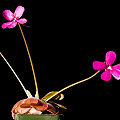Q: What kind of pot should I use?

Byblis liniflora

Pinguicula 'Weser'
A: Dude, I recommend pot from the Mendocino coast. Columbian is also most heinous.
Hah hah hah hah hah hah.
OK, back to business. First, in nearly all cases you should use plastic pots. They are lighter,
require less room, are easier to clean, and do not accumulate harmful impurities or salts.
There are some cases in which clay pots actually are superior, for example in some cases with
Darlingtonia or Drosophyllum, but these are advanced projects best
relegated to the experts.
Second, you should use drained pots so you can flush water through the pot when necessary.
If you are trying to grow a fully aquatic species, a drained pot is unwise.
If you do not understand why this is a problem, pour a glass of water over your head, then
try a hobby that is a little less taxing of your brain; watch football or something.
Thirdly, let us consider pot size. Carnivorous plants do not have well-developed root systems,
so most do perfectly fine well in very small pots.
Yes, there are exceptions such as Byblis gigantea, Drosophyllum, and tuberous
Drosera. But if you are growing these, you probably don't need the FAQ to give you answers.
Be creative. You can put carnivorous plants in many different kinds of pots. Peter D'Amato loves growing plants in truly crazy,
kitschy glazed ceramics. In a similar way, one FAQ-reader named Mike told me he puts plant in old toilets! When I imagine
what a toilet filled with wet peat moss would look like, I am reminded of a gas station bathroom I once visited in eastern Texas. (Shudder.)
Page citations: reader contributions, personal observation